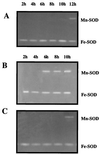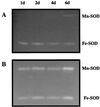Gene expression in Pseudomonas aeruginosa: evidence of iron override effects on quorum sensing and biofilm-specific gene regulation
- PMID: 11222597
- PMCID: PMC95094
- DOI: 10.1128/JB.183.6.1990-1996.2001
Gene expression in Pseudomonas aeruginosa: evidence of iron override effects on quorum sensing and biofilm-specific gene regulation
Abstract
Prior studies established that the Pseudomonas aeruginosa oxidative stress response is influenced by iron availability, whereas more recent evidence demonstrated that it was also controlled by quorum sensing (QS) regulatory circuitry. In the present study, sodA (encoding manganese-cofactored superoxide dismutase [Mn-SOD]) and Mn-SOD were used as a reporter gene and endogenous reporter enzyme, respectively, to reexamine control mechanisms that govern the oxidative stress response and to better understand how QS and a nutrient stress response interact or overlap in this bacterium. In cells grown in Trypticase soy broth (TSB), Mn-SOD was found in wild-type stationary-phase planktonic cells but not in a lasI or lasR mutant. However, Mn-SOD activity was completely suppressed in the wild-type strain when TSB was supplemented with iron. Reporter gene studies indicated that sodA transcription could be variably induced in iron-starved cells of all three strains, depending on growth stage. Iron starvation induction of sodA was greatest in the wild-type strain and least in the lasR mutant and was maximal in stationary-phase cells. Reporter experiments in the wild-type strain showed increased lasI::lacZ transcription in response to iron limitation, whereas the expression level in the las mutants was minimal and iron starvation induction of lasI::lacZ did not occur. Studies comparing Mn-SOD activity in P. aeruginosa biofilms and planktonic cultures were also initiated. In wild-type biofilms, Mn-SOD was not detected until after 6 days, although in iron-limited wild-type biofilms Mn-SOD was detected within the initial 24 h of biofilm establishment and formation. Unlike planktonic bacteria, Mn-SOD was constitutive in the lasI and lasR mutant biofilms but could be suppressed if the growth medium was amended with 25 microM ferric chloride. This study demonstrated that (i) the nutritional status of the cell must be taken into account when one is evaluating QS-based gene expression; (ii) in the biofilm mode of growth, QS may also have negative regulatory functions; (iii) QS-based gene regulation models based on studies with planktonic cells must be modified in order to explain biofilm gene expression behavior; and (iv) gene expression in biofilms is dynamic.
Figures






References
-
- Bradford M M. A rapid and sensitive method for the quantitation of microgram quantities of protein utilizing the principle of protein-dye binding. Anal Biochem. 1976;72:248–254. - PubMed
-
- Braun V, Schaffer S, Hantke K, Troger W. Regulation of gene expression by iron. In: Hauka G, Thauer R, editors. The molecular basis of bacterial metabolism. Heidelberg, Germany: Springer-Verlag; 1990. pp. 164–179.
-
- Brown M R W, Anwar H, Lambert P A. Evidence that mucoid Pseudomonas aeruginosa in the cystic fibrosis lung grows under iron-restricted conditions. FEMS Microbiol Lett. 1984;21:113–117.
Publication types
MeSH terms
Substances
Grants and funding
LinkOut - more resources
Full Text Sources
Other Literature Sources
Medical

